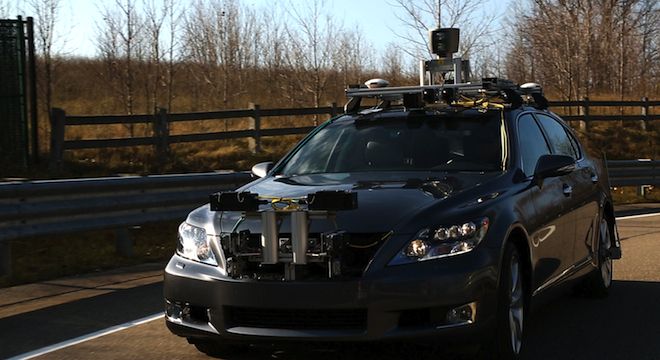Toyota and Audi turned heads earlier this month by announcing that they were following in Google’s tracks and developing partially self-driving, or “autonomous” vehicle technology systems of their own.
At that time, Toyota noted in press materials that it has been testing one such semi-autonomous vehicle system — the Intelligent Transportation System (ITS), which uses short wave radio signals to have cars communicate with other vehicles and surrounding infrastructure to avoid collisions — at a simulated city inside its Higashi-Fuji Technical Center in Susono City, Japan.
Toyota also said that further “research and development will continue at Toyota Research Institute, North America (TRiNA), in Ann Arbor, Mich.”
But Toyota has actually already been testing some self-driving technology on a closed course at its facilities in Ann Arbor, as a spokesperson for the world’s largest automaker revealed to TPM.
“At least one previous vehicle was in operation on test roads on our facility in Ann Arbor a year ago,” Cindy Knight, Toyota public affairs manager, told TPM in a phone interview. “There has been some driving on public roads in vicinity of the Toyota Technical Center (TTC) in Ann Arbor, but most has been on a closed course test track outdoors that’s only used by engineers.”
However, Toyota’s engineers are not yet “divulging any details about the testing program,” Knight told TPM, including refraining to disclose for now how many hours or miles Toyota’s autonomous test car has been on the roads.
Knight said that the company’s overall program to develop semi-autonomous and eventually, fully autonomous vehicles for consumer usage was still “so unofficial within the company that we don’t actually have a name for our driving system yet.”
Instead, Toyota just refers to its efforts as the “advanced active safety research vehicle.” It uses a modified Lexus LS for these experiments, as the company revealed on January 7 and in the following days at the annual Consumer Electronics Show in Las Vegas.
That contrasts with Google, which in August 2012 announced that its own fleet of experimental self-driving cars that include several modified Toyota Prius models and the Lexus RX450h (also by Toyota) had logged over 300,000 miles of test drives.
Google bought those cars on its own, though, and Toyota is not working with the Internet giant on self-driving technology.
“Both [autonomous vehicle] development programs are completely separate,” Knight told TPM. “Our engineers haven’t exchanged information, nor cooperated with Google.”
That said, Knight told TPM the relationship between Google and Toyota was “cordial.”
Toyota also isn’t working with Audi or parent company Volkswagen, which are also pursuing self-driving car technology and showed off a self-parking, automatic “valet” system on an Audi A7 at the Consumer Electronics Show in Las Vegas in early January.
Yet the hardware underlying all of the three companies’ separate self-driving efforts is fundamentally similar, according to Knight. It’s the software systems synthesizing the data collected by the hardware and guiding the cars by each company that differ, as Knight explained it.
“It’s safe to say that all of us [Toyota, Audi and Google] are generally using the same type of equipment,” Knight told TPM.
That equipment includes radar, GPS antennae, gyroscopes, stereo cameras and Light Detection and Ranging (LIDAR), a rotating sensor that sits atop the roof of the vehicles and which measures distances by bouncing lasers off targets and collecting backscattered light. Check out an image Toyota shared earlier in January of one such LIDAR sensor atop its modified Lexus LS:

“Even the positioning and types and array of those sensors are changed all the time,” Knight said. “A lot of the research is just testing how all those sensors work.”
Given that Toyota’s autonomous car efforts are still in their early stages, the company has declined to specify a timeframe for when consumers or businesses could have access to the technology. Audi previously told TPM it would be technologically advanced enough to deploy such semi-autonomous systems for the consumer market within a decade, though Audi noted that there remain significant regulatory and legal hurdles before it is ready to do so.






